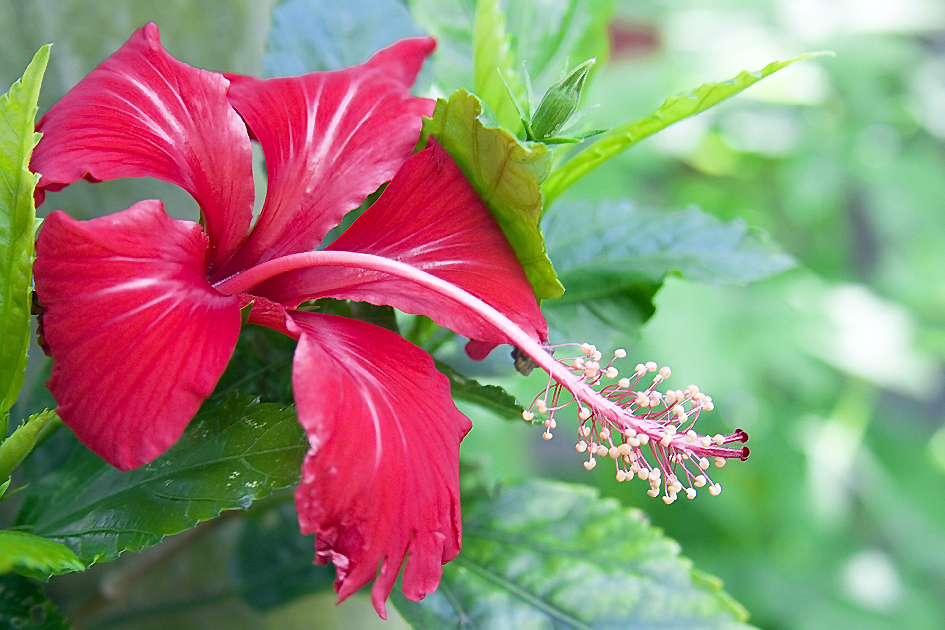- Hibiscus
taxobox
name = "Hibiscus"
image_caption = A red hibiscus flower inSydney ,Australia during late spring
regnum =Plantae
unranked_divisio =Angiosperms
unranked_classis =Eudicots
unranked_ordo =Rosids
ordo =Malvales
familia =Malvaceae
genus = "Hibiscus"
genus_authority = L.
subdivision_ranks =Species
subdivision = Over 200 species|"Hibiscus", or rosemallow, is a large genus of about 200–220 species of
flowering plant s in the familyMalvaceae (the mallow family, along with members likecocoa ,cotton ,okra ,baobab anddurian ) native to warm, temperate, subtropical and tropical regions throughout the world. The genus includes both annual and perennialherbaceous plants, and woodyshrub s and smalltree s.Description
The leaves are alternate, simple, ovate to lanceolate, often with a toothed or lobed margin. The
flower s are large, conspicuous, trumpet-shaped, with five or morepetal s, ranging from white to pink, red, purple or yellow, and from 4-15 cm broad. Thefruit is a dry five-lobed capsule, containing severalseed s in each lobe, which are released when the capsule splits open at maturity.Uses
Many species are grown for their showy
flower s or used as landscapeshrub s. Hibiscus is also a primary ingredient in many herbal teas.One species of "Hibiscus", known as
Kenaf ("Hibiscus cannabinus"), is extensively used inpaper making. Another, roselle ("Hibiscus sabdariffa") is used as avegetable and to makeherbal tea s andjam s (especially in the Caribbean).In
Mexico , the drink is known as Jamaican water or agua de Jamaica and is quite popular for its color, tanginess and mild flavor; once sugar is added, it tastes somewhat like cranberry juice. Dieters or persons with kidney problems often take it without adding sugar for its beneficial properties and as a naturaldiuretic . It is made by boiling the dehydrated flowers in water; once it is boiled, it is allowed to cool and drunk with ice. [http://vinculando.org/mercado/flor_jamaica.html]In Egypt and Sudan, roselle petals are used to make a tea named after the plant
karkade ."Hibiscus" species are used as food plants by the
larva e of someLepidoptera species including "Chionodes hibiscella", "Hypercompe hambletoni", the Nutmeg moth, and theTurnip Moth .The Hibiscus is used as an offering to Goddess
Kali and LordGanesha inHindu worship.The Gumamela or Hibiscus rosa sinensis linn flower has antifungal, emmenagogue, emollient and refrigerant effect. [240]The bark of the hibiscus contains strong fibers. They can be obtained by letting the stripped bark sit in the sea in order to let the organic material rot away. In
Polynesia these fibers (fau, pūrau) are used for making grass skirts. They have also been known to be used to make wigs.Hibiscus, especially white hibiscus, is considered to have medicinal properties in the Indian traditional system of medicine,
Ayurveda . Roots make various concoctions believed to cure various ailments.The natives of southern India use the Red hibiscus ("Hibiscus rosa-sinensis") for hair care purposes. The red flower and leaves, extracts of which can be applied on hair to tackle hair-fall and dandruff on the scalp. It is used to make hair-protective oils. A simple application involves soaking the leaves and flowers in water and using a wet grinder to make a thick paste, and used as a natural shampoo.
Dried hibiscus is edible, and is often a delicacy in Mexico.
The hibiscus flower is traditionally worn by
Hawaii an women. A single flower is tucked behind the ear. Which ear is used indicates the wearer's availability for marriage.National symbol
"Hibiscus syriacus" is the national flower of
South Korea ."Hibiscus rosa-sinensis" is the national flower ("Bunga Raya") of Malaysia.
Care
Hibiscus flowers need to be taken care of in warm temperatures. They bloom best with temperatures ranging from 60 to 90 degrees. The hibiscus needs to be watered carefully. Make sure you do not overflood the roots. Keep a steady flow of water for the plant in warm weather. In colder weather, only water the plant if it looks dry. Hibiscus needs to be fed plant food. Try to keep all insects and pests away so the flower does not get ruined. If you are potting your flower, make sure the pot has plenty of drainage.
pecies
In temperate zones, probably the most commonly grown ornamental species is "
Hibiscus syriacus ", the common garden Hibiscus, also known in some areas as the "Rose of Althea" or "Rose of Sharon" (but not to be confused with the unrelated "Hypericum calycinum ", also called "Rose of Sharon"). In tropical and subtropical areas, theChinese hibiscus ("H. rosa-sinensis"), with its many showy hybrids, is the most popular hibiscus.About 200-220 species are known, including:
*"Hibiscus acetosella "
*"Hibiscus arnottianus " - Koki'o 'ula
*"Hibiscus brackenridgei " - Ma'o hau hele
*"Hibiscus calyphyllus "
*"Hibiscus cameronii "
*"Hibiscus cannabinus " -Kenaf
*"Hibiscus cisplatinus "
*"Hibiscus clayi " -Hawaiian hibiscus (red)
*"Hibiscus coccineus "
*"Hibiscus dasycalyx " - Neches River rose-mallow
*"Hibiscus denudatus " -Pale face
*"Hibiscus diversifolius "
*"Hibiscus elatus "
*"Hibiscus fragilis " -Mandrinette
*"Hibiscus furcellatus " - 'Akiohala
*"Hibiscus fuscus "
*"Hibiscus grandiflorus "
*"Hibiscus coccineus "
*"Hibiscus hamabo "
*"Hibiscus hastatus "
*"Hibiscus heterophyllus "
*"Hibiscus indicus "
*"Hibiscus insularis " - Phillip Island Hibiscus
*"Hibiscus laevis " -Halberd-leaved rosemallow
*"Hibiscus lasiocarpos "
*"Hibiscus lavaterioides "
*"Hibiscus ludwigii "
*"Hibiscus macrophyllus "
*"Hibiscus militaris " - Syn. of "Hibiscus laevis"
*"Hibiscus moscheutos " - Swamp Rose-mallow
*"Hibiscus mutabilis " -Cotton rosemallow
*"Hibiscus paramutabilis "
*"Hibiscus pedunculatus "
*"Hibiscus platanifolius "
*"Hibiscus radiatus "
*"Hibiscus rosa-sinensis " -Chinese hibiscus
*"Hibiscus sabdariffa " - Roselle or Omutete or Sorrel
*"Hibiscus schizopetalus "
*"Hibiscus scottii "
*"Hibiscus sinosyriacus "
*"Hibiscus syriacus " - Hibiscus
*"Hibiscus tiliaceus " - Hau
*"Hibiscus trionum " -Flower-of-an-Hour
*"Hibiscus waimeae " - Koki'o ke'oke'oExternal links
* [http://www.balconmicrobio.com/news.php?news=38 Some curiosities about hibiscus (Spanish)]
Wikimedia Foundation. 2010.
